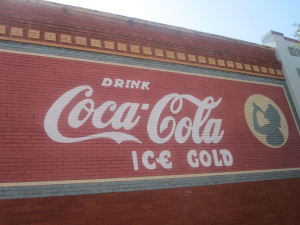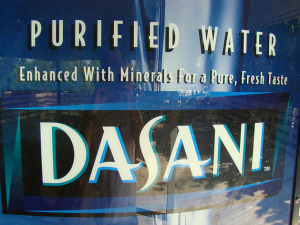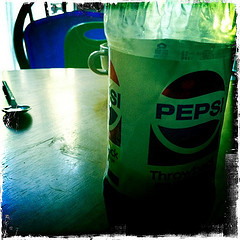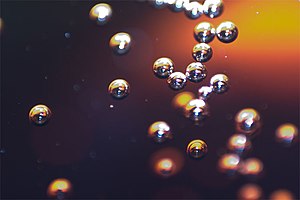This post is presented by SBE, the Society for Biological Engineering--a global organization of leading engineers and scientists dedicated to advancing the integration of biology with engineering.

Your faithful couch potato reports: I thought that the Coke and Pepsi wars, which began in the 70's (click to see a vintage, Michael Jackson, Pepsi TV ad), were long over, comfortably settled into a tit-for-tat, high-fructose-opoly. Now, suddenly, beverage industry magazines are reporting that the cola wars have erupted again. Pundits screaming, who will win the millennials? (Did I miss something? Maybe I've been in an American Idol Coke-logo-induced-trance too long?) So, what happened? First, back to the beginning--the 70's. A quick Tivo search--skipping anything by Aaron Sork--I mean, Spelling: charlie'sangelsstarskyandhutch... dynastyloveboatfantasyislandthewestwing... What's left? Maybe Miami Vice, but I didn't see anyone drinking Coke or Pepsi. Moving further into the past. The series of 70's, TV commercials that set off the first cola wars: the Pepsi Taste Tests (click to see), which, strangely, Pepsi always won. (Finally, a smoking gun.) Then Coke struck back, retaliating with mega, feel-good commercials (here). And on and on and on...until it just became background noise. Cultural over-carbonation. Since the beginning, the two cola companies have spent hundreds of millions of dollars to prolong the war, while most other carbonated drink makers survived by huddling out of the line of fire. It's a long struggle that has even outlived the Cold War, when Nixon and Khrushchev sipped Pepsi before their famous kitchen debate; until Clinton drank Diet Coke during his deposition; and a singing, then smoldering Michael Jackson in between (here). Colas are the Forrest Gump of American snack foods and beverages. Just to avoid Cold War nostalgia, Risk, the popular board game, should be played as a Pepsi-Coke corporate grudge match for global domination. The game's constant losers peddling minor brands like Dr Pepper and Hire's Root Beer.
A new war is heating up over carbon footprints
Now the Cold War era's only remaining rivalry is back (click this parody video), but the stakes are even higher. The battle is being fought on two fronts. The first: these two sprawling corporations have multiple brands and divisions fighting for shelf space and eco-youth appeal. Maclean's highlights:
Pepsi and Coca-Cola have long been retooling their arsenals, loading up on products that appeal to a health-conscious public like teas, energy drinks, and bottled water. Pepsi has invested heavily in Gatorade, while Coke owns numerous non-carbonated brands, including Vitaminwater and Minute Maid. ...Coke has been marketing heavily on television shows like American Idol and with commercials during the Super Bowl... Pepsi... this year, the brand that once counted Michael Jackson as a pitchman plans to spend 30 percent more on television ads in the U.S., including $59 million to sponsor the television talent show The X Factor, reports the Wall Street Journal.
The second front is technological. While searching to cut costs and shrink their carbon footprint, both companies have been developing new and different bottling technologies as they move away from petroleum to a 100% biomass bottle.

In 2009, in a bid to one-up Pepsi, and cultivate attention among more environmentally savvy and up-scale customers, Coke unveiled the first PlantBottle, a recyclable Dasani water bottle made from a blend of 30% Brazilian sugarcane and molasses, and 70% petroleum. It was a significant improvement over Coke's traditional petroleum-based, PET (polyethylene terephthalate) plastic bottles, which were made of two components--MEG (mono-ethylene glycol), 30% of the PET by weight, and PTA (purified terephthalic acid), which makes up the other 70%. Upping their eco-cred, Coke claimed that the cane is grown on degraded pastures located over 2,000 km from the Amazon, with little impact on biodiversity, and it's also predominantly rain-fed. After sugarcane is harvested, according to the Wall Street Journal, it's crushed andmashed into juice, then fermented and distilled into ethanol. Through a series of chemical processes such as oxidation, that ethanol is then converted to a mono-ethylene glycol or MEG--a component normally derived from petroleum. The MEG is then mixed with pertoleum-based terephthalic acid to create PET plastic. Because the end product is still PET, the new bottle has the same shelf life, recyclability and appearance, and it reduces its carbon footprint about 19%. In 2010 alone, 30,000 metric tons of carbon dioxide were eliminated--the same impact as 60,000 barrels of oil from PET plastic bottles. (Were the millennials swooning? Not yet, but curious.) The Plantbottle PET resin is finally blow-molded in factories like Southeastern Container's 500,000-square-foot, Ohio plant, where 100 employees produce hundreds of millions of bottles that are distributed throughout the midwest and Canada. John Fischer, Southeastern's general manager, told Plastics News:
"It was just dropped right in behind the previous non-plant resin... [Coca-Cola] did their homework, Fischer said. "...we just had to adjust the profiles a little bit for different heat values, adjust the air a little and off it went. It's a good looking bottle..." (click to see plant video)
Above is a commercial for the first Plantbottle. While Coke chose Dasani water to be the pilot product, the new bottle is now in nine major markets in a variety of brands--including Coke itself. There shouldn't be any doubt about the ad's message and it's impact on potential customers. It was a huge success. Coke has produced over 2.5 billion Plantbottles since its introduction in 2009, and they expect to double the output in 2011. Coke has even created a 100% plant-based bottle in its labs, but its scientists are still trying to find a way to make it commercially viable. When Coke rolled out the Dasani Plantbottle, Pepsi scientists had been secretly working to perfect their more ambitious 100% bio-bottle. But the design still needed to be refined, so they had to watch as Coke basked in a very publicized PR glow. The quasi-divine nimbus of mainstream media approval smoothed over still high, water, energy, and recycling costs. At the time, Pepsi could only unveil Acquafina's latest Eco-Fina "light weighted" bottle (click to read the press release). Although Pepsi's new bottle would save about 75 million pounds of plastic a year, it was still part of an industry-wide trend--hardly cutting edge science--so the media focus shifted and remained on Coke. Trend-sensitive magazines like Fast Company moved from initial skepticism to praise.
The Cola Wars Escalate
While Coke's goal is still to make a 100% plant-based bottle, transitioning all their brands by 2020, they've been getting a lot of publicity for a long-term promise. Pepsi had been feeling punk'd, and couldn't sit on their research and out of the limelight any longer. Finally, two years after Coke's first Plantbottle rollout, Pepsi unveiled its new bottle on March 15: the first of its kind, the company says, to be made entirely from plant materials, which include switch grass, pine bark, and corn husks. Eventually, potato scraps, orange peels, oat hulls and other leftovers from Pepsi's food business will also be found in the bottles. Which also means that it can be locally sourced. The company said, keeping the actual details under wraps, that by combining biological and chemical processes, it has come up with a way to create a molecular structure that is identical to petroleum-based PET using plant-based materials. While Coca-Cola has been pushing for industry-wide adoption of its PlantBottle, already persuading Heinz Ketchup to buy its technology (read press release), it knows that it will take several years before the company's Plantbottles reach 100 percent biomass content. Pepsi, however, will test its 100-percent plant-based bottles in 2012 and promises to quickly restock supermarket shelves. "We've cracked the code," said Rocco Papalia, senior vice president, to the Associated Press. The bottle not only offers a significantly reduced carbon footprint compared to petroleum-based PET, but is also 100 percent recyclable. The new bottle looks, feels, and protects the drink inside exactly the same as its current bottles, he added. "It's indistinguishable." "This is the beginning of the end of petroleum-based plastics," Allen Hershkowitz, a senior scientist with the Natural Resources Defence Council. "When you have a company of this size making a commitment to a plant-based plastic, the market is going to respond."
The Cola Wars go on and on...

Pepsi's news was barely a two weeks old when Odwalla, Coca-Cola's fruit juice and smoothie specialty division, fired a loud shot at Pepsi, saying they were putting a 100% plant-based bottle on store shelves now.(click to read press release) The Odwalla PlantBottle is now at least 96 percent and up to 100 percent plant-based materials derived from sugar cane--and is still recyclable in existing facilities. Single-serve Odwalla packages are made from up to 100 percent plant-based materials with high-density polyethylene (HDPE) plastic, one-upping Pepsi's plant-based bottle. Odwalla estimated that the new plant-based packaging will save up to the equivalent of 400,000 gallons of gas annually, compared with the petroleum-based plastic bottles it (and just about every other bottled drink company) now uses. The PlantBottle is also expected to have the same shelf life, weight, composition and appearance as conventional petroleum-based plastic. The Cola Wars go on and on...downloading a Mariah Carey, Pepsi ringtone probably won't change much? But... A couch potato's final thoughts: This long-standing feud has helped create (in the Al-Gore-internet sense) at least four industries: advertising, television, Barcaloungers, and weight loss. Now it's contributing to another--advances in sustainability, and spreading new technologies that can be used to curb the world's petroleum snack-fest. A little portion control. Now colas can become the Jenny Craig of global snack culture. That's something a millennial can believe in...





Comments
Great article! So will we see big oil farming soon?
in many different forms.
Terrific post! Coke vs Pepsi Battle to Make First 100% Plant-Based Bottles | ChEnected | Engineers talk chemicals, bio, safety, energy, sustainability. really tends to make my life a little bit nicer :D Keep on together with the awesome posts! Best regards, We have